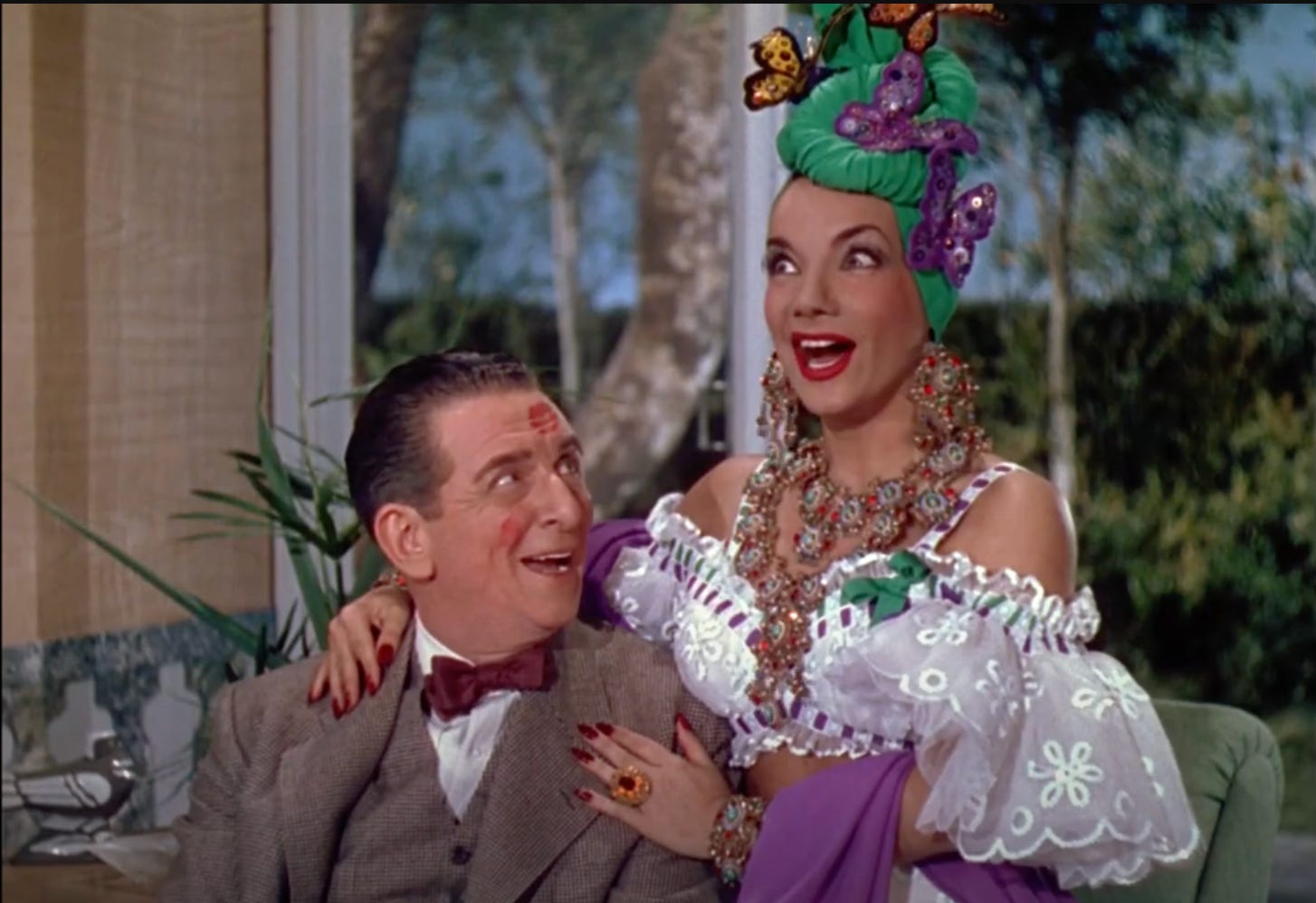There is a photograph of a young Carmen Miranda at school that is very far from her later image as the lady in the tutti-frutti hat; this little girl looks very dispirited, very depressed, very far from the star with the broad, saucy smile that closed her eyes shut with pleasure. But through performing and resplendent costumes and the insistently cheerful beat of samba music, Miranda created a version of herself that delighted many, and perplexed and repulsed others.
Miranda was born in Portugal in 1909, but her family moved to Brazil when she was a child, and she was Brazilian by culture, by inclination, by choice, though she always retained her Portuguese citizenship. Convent educated, Miranda started selling ties at a local store at the age of 14; as she got older she acquired a hunky and socially prominent boyfriend who introduced her into Rio society. Miranda also worked as a milliner, which would come in handy for the ever-more-elaborate hats she would wear in her later professional life.
During the 1930s, Miranda became a popular recording star in Brazil and appeared in a few movies, and in 1939 she first wore a fruit-hat turban, which was the traditional dress of girls who sold fruit in the Brazilian state Bahia. Theater impresario Lee Shubert saw her on a visit to Rio and gave her a contract to play in a revue in New York called The Streets of Paris, and she signed over 50% of her earnings to him, but Miranda insisted on bringing her own band to America because she knew that her musicians would play the very elaborate rhythms of her music better than any American musicians could.
A sensation on stage with a high velocity style that was soon parodied by other performers, Miranda was filmed in New York in three numbers for the Technicolor Fox musical Down Argentine Way (1940), opening that film with a confrontational delivery of the title number straight to the camera and later doing one of her trademark tunes, “Mamãe eu quero.” (Mickey Rooney did this song for his Miranda send-up in Babes on Broadway {1941}, which ends on a boyish squawk of, “Hey, Ma!”)
Known as the Brazilian Bombshell, Miranda was integrated into the plots of her follow-ups for Fox out in Hollywood, That Night in Rio (1941) and Week-end in Havana (1941), both of which starred Alice Faye. Miranda’s comic style in those pictures is more than a little much, too broad, for a little of her always goes a long way, but by the time of Springtime in the Rockies (1942) she had gained more control and got her laughs opposite the character actor Edward Everett Horton, with whom she had a surprising sort of chemistry. The meaning of Miranda and her cartoonish image in her 1940s Hollywood movies can be difficult to interpret or rescue, but she seemed most comfortable opposite gay leading men like Horton and Cesar Romero, and she swiftly became a camp favorite in the gay underground.
In her best film, Busby Berkeley’s The Gang’s All Here (1943), Miranda is moved fruitfully into an area of visual surrealism, and during the production number “The Lady in the Tutti-Frutti Hat” she defends herself, irresistibly: "Some people say I dress too gay…but every day I feel so gay...and when I’m gay, I dress that way...is something wrong with that? No-o!” That “No-o!” of hers is a rallying cry for all misfits, and very lovable.
Miranda was always basically a novelty act, but Fox moved her more to the center of Greenwich Village (1944) and Something for the Boys (1944), after which she was very much demoted for Doll Face (1945). Miranda’s starring effort opposite Groucho Marx, Copacabana (1947), was pleasant enough, and she enjoyed pretending to be a French character as part of the plot; she also gained herself a husband here, a man she met on the set named David Sebastian.
A very high-paid performer by this point, the prone-to-depression Miranda moved to MGM and tried to teach Wallace Beery how to rhumba in A Date with Judy (1948), but by 1953 she was reduced to appearing opposite Dean Martin and Jerry Lewis in Scared Stiff (1953). Her personal life was not of the happiest at this point.
An addiction to prescription drugs likely put a strain on Miranda’s heart, and in her last appearance, on Jimmy Durante’s TV show in 1955, she visibly sinks to one knee during a dance number; at a party after the filming Miranda danced and sang and laughed it up with friends and then died, at age 46, a tornado of pushed positive energy to the end.
Yes, she played and played up a stereotype during the age of the Good Neighbor Policy with South America, but Miranda was also in the spirit of violent comic wartime female stars like Betty Hutton and Martha Raye, and her reputation as a specialty act sometimes lets her get away with some subversive messaging: “Of course I’m a woman...do I look like a man?” she asks in The Gang’s All Here, a question that feels fairly loaded now in this age of drag and presentation of gender signifiers. Maybe we should reject her. I can’t. I yi-yi-yi-yi like her very much.








She was extremely campy, that's why gay men adored her.
There is a super documentary out in the world (mid-90’s) called “Bananas is my Business “ about Miranda. It played on PBS back then. Fascinating stuff!